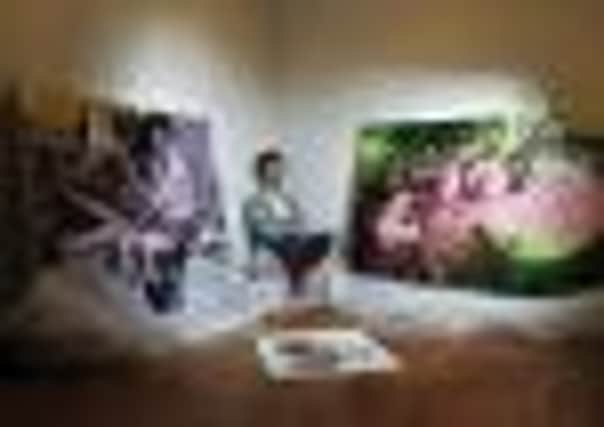Interview: Kirsty Whiten, artist


KIRSTY Whiten has a vivid memory from her degree show at Edinburgh College of Art. Eavesdropping on people as they looked at her work, she spotted a woman leaning closely into one of her intricately drawn pencil portraits, “because she wanted to see the details. Then she realised it was a picture of an old lady with her hand down her pants. She sort of recoiled slightly from it, then went back in again. I was like, ‘Yes, that’s something I want to achieve.’”
Whiten, 34, is one of Scotland’s most distinctive artists, and one of the hardest to pin down. Looking at her paintings, prints and drawings, the first phrase that springs to mind is old-fashioned craftsmanship – her work is careful, precise and rich in fine detail, all the qualities that some people complain are absent from much contemporary art, but which will win you respect from more conservative galleries and art fairs.
Advertisement
Hide AdAdvertisement
Hide AdBut it is also fiercely contemporary in the way it challenges conventions and taboos, particularly in relation to gender and sexual politics. Whiten’s 2005 show, Feral Lingerie Model (see panel, right), was a collection of pencil drawings of a naked feral woman hunted through a forest by a strange group of anthropologists and fashionistas, who knocked her out with tranquiliser darts before dressing her up in skimpy underwear. Votive Icons, from the following year, mixed religious iconography with masturbation. A later collection of work, Donkey Hostage, depicted couples playing surreal, sadomasochistic power games involving bondage and animal costumes. In terms of subject matter, Whiten is following in the footsteps of provocative, complex artists like Cindy Sherman and Linder Sterling.
The result is that, while she has plenty of supporters in the art world, she is often unsure where she fits in. “The contemporary art galleries where strong conceptual work is shown kind of can’t bear if you draw representationally,” she says. “You have to be utterly ironic about it and I don’t want to be. I want to be direct. But it’s an uncomfortable mix for a lot of people.” She laughs. “I’m just deeply unfashionable. What can I do?”
When we meet, however, she’s set up camp in “the perfect place” for her work, Edinburgh Printmakers. It’s a gallery which, as Whiten says, values traditional techniques – she is at her most animated when talking about lithography – but which is “definitely a cutting-edge contemporary art establishment as well, and they pick artists with that kind of sensibility, It’s quite rare to find the balance of those two things.”
The show she is opening at the Printmakers this weekend, Breeder Badlands, marks a new phase in Whiten’s work – a set of prints and large-scale paintings of parents (friends of Whiten, and – for the first time in her work – Whiten herself) with their small children. Whiten has a young son and daughter, and recently relocated from Edinburgh to a small village in Fife, where she and her musician partner have spent three years designing and building their own house. Cliché dictates that when artists have families and move to the countryside, they lose their edge – especially when they start making work about their children. As always with Whiten’s work, though, Breeder Badlands defies expectations.
“I really detest pictures that sentimentalise the family unit and the cuteness of little children,” she says. “I don’t want anything to do with that.” Instead, she suggests, the new show follows in the footsteps of Feral Lingerie Model, in its preoccupation with the conflict between “civilised” society and people’s ancient, animal instincts. Whiten’s father is an evolutionary psychologist who studies apes, and has been a significant influence (if indirectly) on her work. If she is not drawing actual monkeys, she often depicts humans in animal-like poses. While pregnant with her first child, Whiten remembers, she had scientific discussions with her father about mother-child conflict, the way “the baby needs to take as much as possible from its mother without killing her. There is a conflict between you and your children, between self-preservation and dissolving into a unit.”
She describes Breeder Badlands as an attempt to capture a raw but complex intimacy between parents and children that isn’t often seen by outsiders, “the more uncomfortable elements of how you interact with your infant. It’s frightening, wildly beautiful and physical but also very claustrophobic. I was completely taken aback when it happened to me, because you don’t see other people doing it.”
The new work is based on photographs Whiten took of friends, naked with their young children. It was, she acknowledges, “quite an intimate thing to ask people to do”. One friend had second thoughts, which is why the show includes an image of Whiten herself, naked with her baby daughter pulled tight to her chest, like an animal that has suddenly sensed danger.
Advertisement
Hide AdAdvertisement
Hide Ad“That’s really poignant to me, this idea of perceived threat,” she says. To further explore this, she painted her families in forest settings. “It’s unsettling because you can recognise in that plainer context something about your connection to all the people who came before you, people who have raised children in much more difficult situations.” Whiten describes her forest settings, half-jokingly, as “post-apocalyptic”. I tell her I think they look like something out of a fairytale. She’s pleased at this – the ambiguity in Whiten’s images, after all, is one of the most compelling things about them – so our very different interpretations suggest Breeder Badlands is, conceptually, another success. As well as being beautifully crafted.
• Breeder Badlands is at Edinburgh Printmakers from Saturday until 10 March. www.edinburgh-printmakers.co.uk